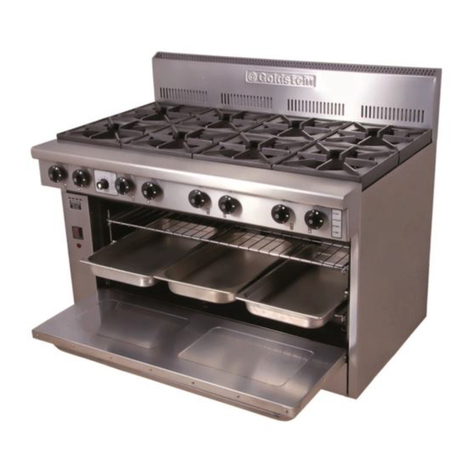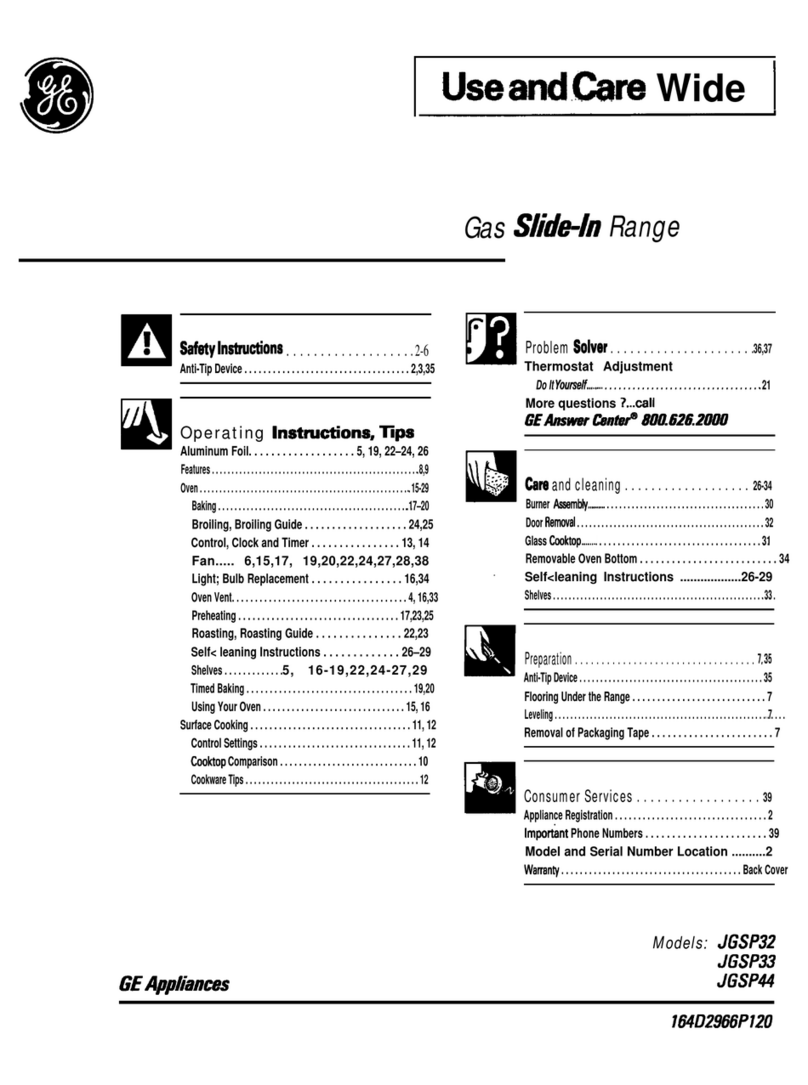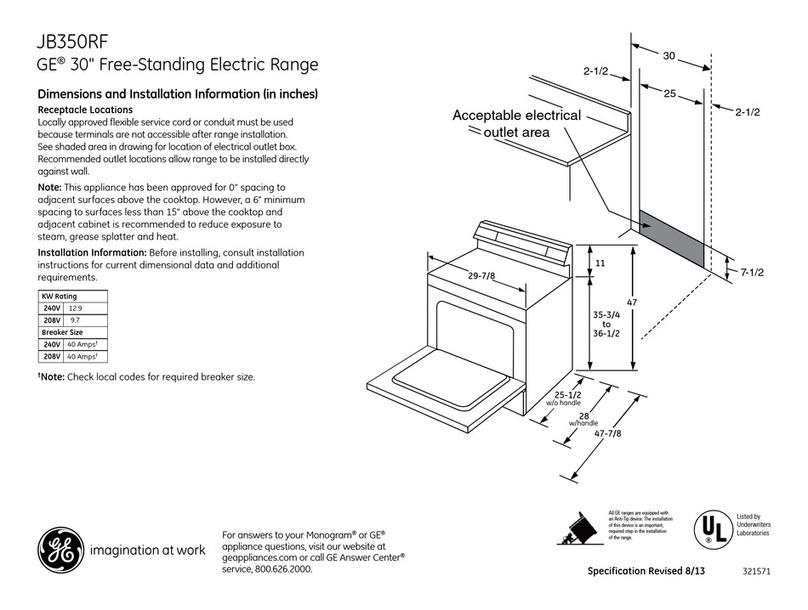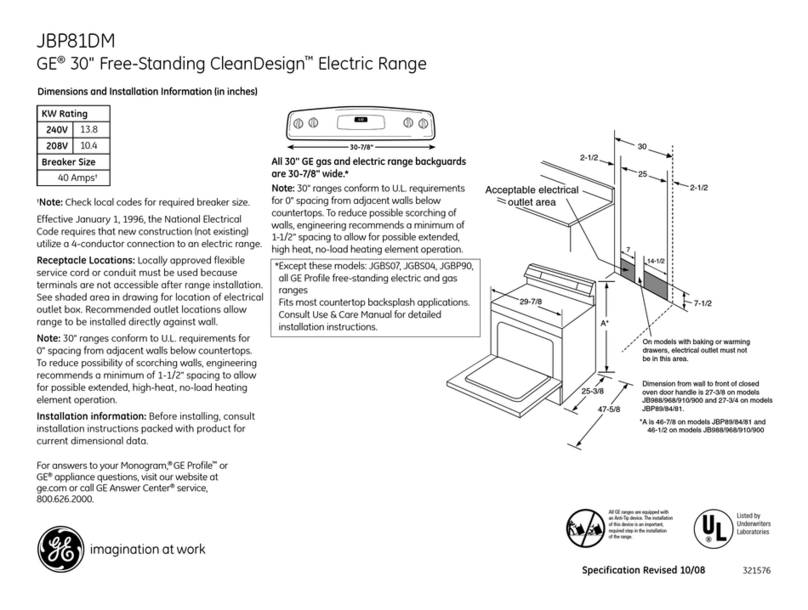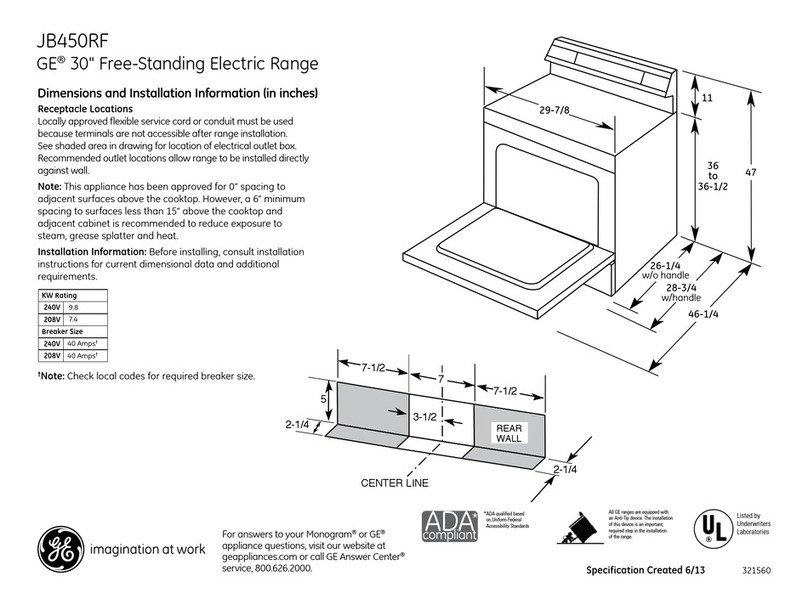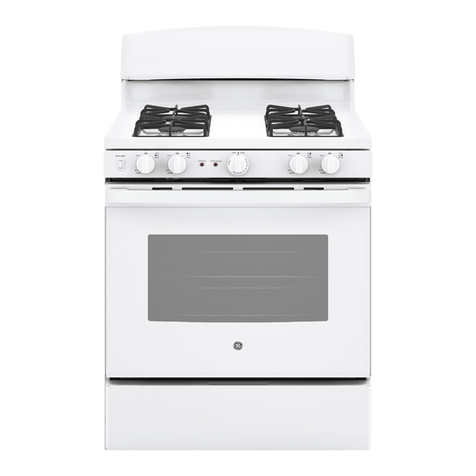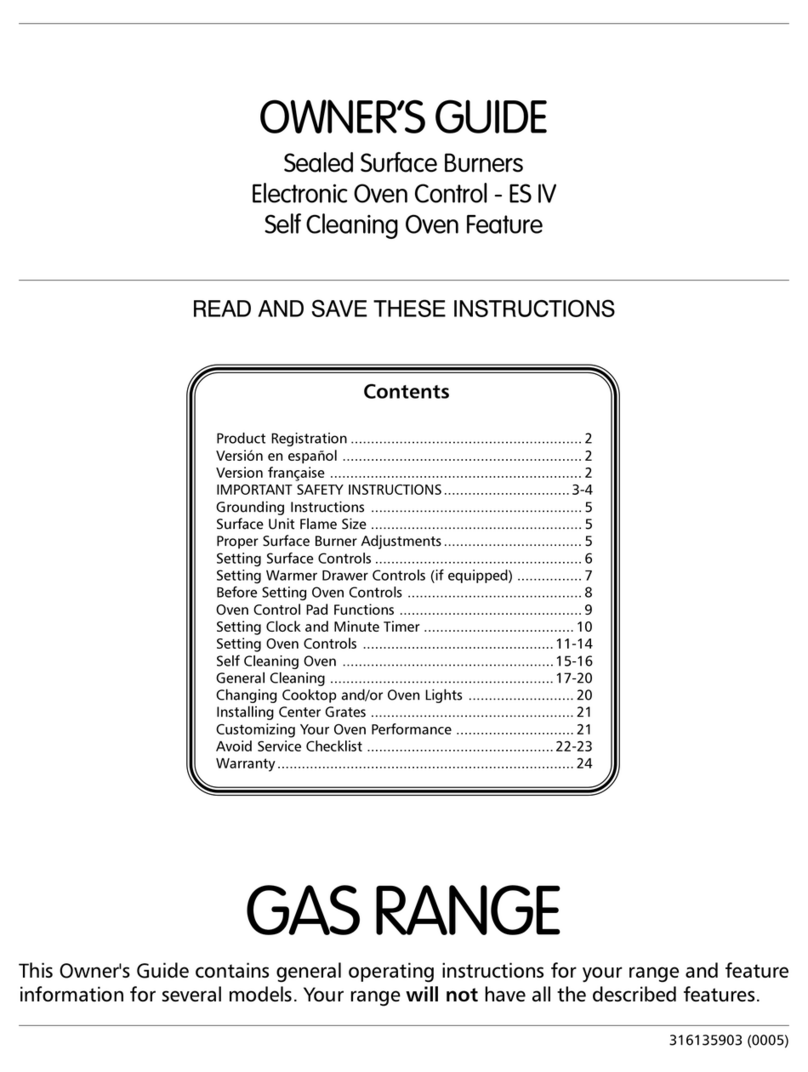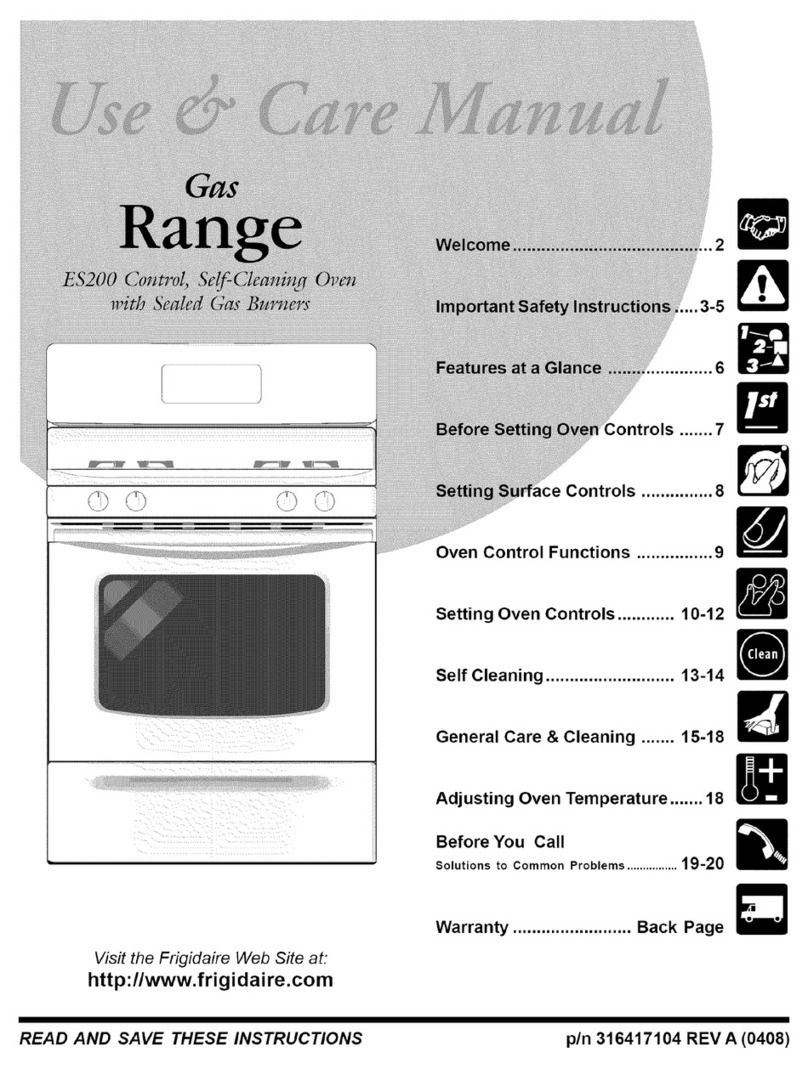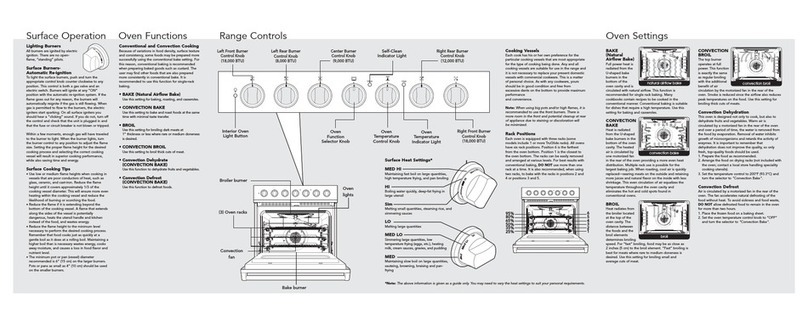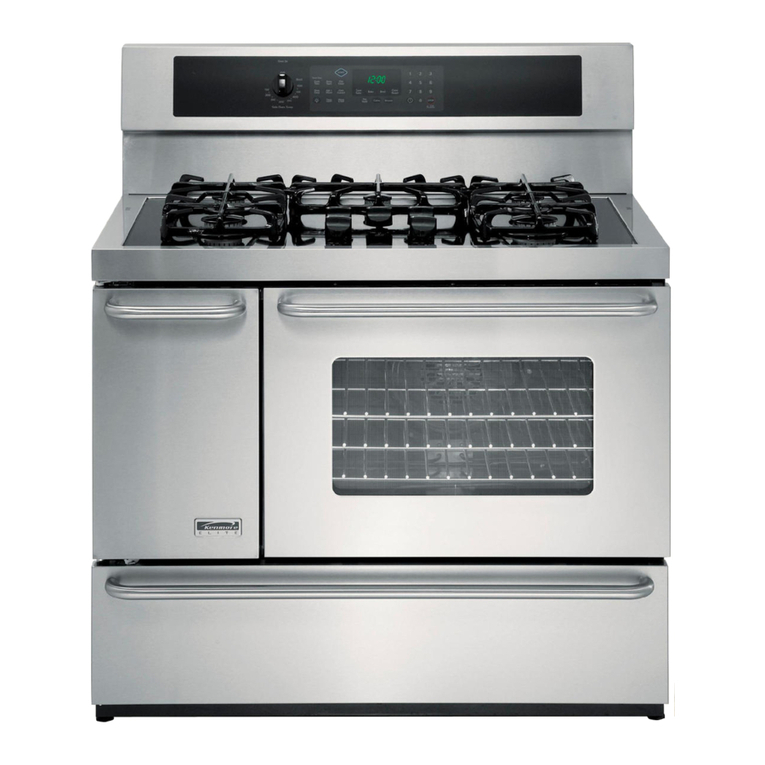goldstein PF-6-28 Reference guide

The Heavyweight 800 Series Performance Plus
And Fan Forced Units
PROUDLY AUSTRALIAN MADE
INSTALLATION PROCEDURE – USER MANUAL
SERVICE INSTRUCTION
MODELS PF-6-28, PF-12G-4-28, PF-24G-2-28, PF-36-28, PF-4-28
FAN FORCED
WINER OF
AUSTRALIAN
CIL
AWARD 1990
DESIGN COUN
PF-6-28
PF-4-20
GAS APPROVAL 20” No.2494 28” 2498
ESTABLISHED 1911
The Cooking Equipment Professionals
www.goldsteineswood.com.au

TABLE OF CONTENTS
1. INTRODUCTION Page 3
2. INSTALLATION Page 4 & 5
3. COMMISSIONING Page 6
4. MAINTENANCE Page 7
5. TRIVETS Page 8
6. PILOT & BURNER OPERATION Page 9
7. CONTROL Page 10
8. THERMOSTAT SETTING Page 11 – 12 - 13
9. PROBLEM SOLVING Page 14 – 15 - 16
10. FAN FORCE Page 17
11. FAN FORCE WIRING DIAGRAM Page 18
12. DRAWINGS Page 19
13. SPARE PARTS Page 20 & 21
14. WARRANTY Page 22
15. BRANCHES Page 23
IM036B2/2

1. INTRODUCTION
Congratulations for purchasing your Goldstein commercial cooking appliance.
J. Goldstein & Co. is a wholly owned Australian company and have been
operating since 1911, building high quality products. The information in this
manual will assist your installer and ensure correct location and connection.
Thoroughly read the user instructions and the user maintenance sections, as
understanding your products, its operation, and its cleaning and service
requirements will provide you with long and satisfactory service. Failure to do
so could shorten the life of the product and decrease its efficiency. Please ensure
only authorised service technicians are called to any difficulties that may arise.
INTRODUCTION
GOLDSTEIN HEAVYWEIGHT 800 SERIES PERFORMANCE PLUS &
FAN FORCED UNITS
MODELS PF-6-28, PF-12G-4-28, PF-24G-2-28, PF-36G-28, PF-4-28.
GOLDSTEIN RANGES designed to give long and satisfactory service and
incorporate the best possible materials and workmanship. Proper installation,
adjustment and preventative maintenance are vitally important if efficiency and
appearance are to be maintained.
Read these instructions carefully as they contain important safety information
regarding the installation, use and maintenance of the appliance.
RECEIVING INSPECTION
•
Check crates for handling damage. After carefully uncrating, check for “concealed”
damage. Report any damage immediately to carrier and to dealer.
•
Remove check all loose items from unit and check contents as found on back of
warranty cards.
•
Check type and capacity of gas supply.
•
The type of gas for which this 800 Series is factory adjusted can be seen on the
rating plate, located on the bottom front panel of the Range.
IMPORTANT
A CLEANER THAT IS COMPATIBLE WITH ALUMINIUM MUST BE USED ON THE
EQUIPMENT OTHERWISE THE GAS PIPING WITHIN THE UNIT WILL BE DAMAGED
AND THIS WILL AUTOMATICALLY VOID THE WARRANTY.
“THE EQUIPMENT MUST BE INSTALLED BY A LICENSED GASFITTER AND
LICENSED CONTRACTOR”
IM036B2/3

2. INSTALLATION
RECEIVING INSPECTION – PRE-INSTALLATION
• Please follow these instructions carefully.
• Remove cartons from unit and check for any damages.
• Report any damages to the transport company or your dealer.
• Lift off base and screw the adjustable legs on the unit,
• Set unit into correct position.
• Adjust feet till they are touching the floor and using a spirit level, level from left to
right.
• Also adjust front to back with a fall of about 2-3mm to the front to help fluing of the
unit.
• This operation is important as variation of 25mm to 76mm in a floor level is found to
be common.
• Make sure unit is under an exhaust hood that provides adequate ventilation.
• Check date plate to ensure appliance is suitable to the gas that it is being connected
to.
• The Rating Plate is located on the front bottom left side and has what the unit is set
up for as factory set and tested.
• Check all loose items listed on the back of the Warranty Card.
• Have your electrician connect a power point as per Electrical Authority and Local
Laws.
• Note: The appliance must be installed by an Authorised person and in accordance
with the regulations of the local Gas Authority AS5601/AG601 and any other
authority having jurisdiction
The appliance has been tested and preset before leaving our Factory, but small
adjustments may be necessary to suit pressure supply.
Correct operation of the appliance must be tested as part of the installation
procedure.
1. Have a licensed gas fitter or your Gas Company connect the appliance to the
gas supply, Location of the connection is on the left side 381mm from the rear
and approximately 114mm from the floor. The fitting is 19mm BSP. The
appliance must be installed in accordance with the rules of any authority
having jurisdiction.
2. The pressure regulator (NG) and LPG standards (AS4563/AG300 1.1.05) are
supplied as a loose item and a hand stop tap must be supplied as close to the
appliance as possible to stop and pressure drop.
IM036B2/4

2. INSTALLATION
INSTALLATION
Please follow these instructions carefully
All equipment must be sitting level for proper operation and combustion where plinth
type installation is made, plinth height and front overhang must be 50 mm minimum.
Levelling can be made by the use of metal shims. For performer series where adjustable
legs are provided, levelling can be made easily due to the threaded construction of the
legs.
LIGHTING INSTRUCTIONS
1. All range and roast ovens are complete with instructions on a Decal attached to
the appliance on the front stainless fascia.
2. Performer range top arrangement:
A. All open burners may be ignited by the constant pilots.
B. Griddle top and hot top sections are provided with flame failure device gas
cocks Model 21S and is ignited by Piezo ignition.
ADJUSTMENT
Adjustments to burners and burner pilots can be made when necessary by any
qualified service organisation or your local gas utility service department.
NOTICE
PLEASE RETURN YOUR WARRANTY CARD
FAILURE TO DO SO WILL VOID WARRANTY
ON THE EQUIPMENT
IM036B2/5

3. COMMISSIONING
To be carried out be Gasfitter or Authority service person
COMMISSIONING APPLIANCE – DETAILS, TESTING, CHECKING PRESSURE ETC.
COMMISSIONING CHECK LIST
1. CHECK FOR DAMAGE AND MISSING PARTS ON BACK OF WARRANTY
CARD.
2. REMOVE ALL PLASTIC COATING FROM S/STEEL PANELS.
3. MAKE SURE ALL PARTS ARE IN THEIR CORRECT POSITION E.G. TRAYS
BURNERS KNOBS.
4. MAKE SURE ALL ELECTRIC AND GAS CONNECTIONS ARE CORRECT AND
TIGHT.
5. LEVEL OFF UNIT LEFT TO RIGHT AND ALSO MAKE SURE THAT FRONT IS
JUST 3-4 MM LOWER TO ALLOW FOR FLUING.
6. TURN ON GAS OR ELECTRICITY
7. ADJUST GAS PRESSURE WITH THREE-QUARTERS OF THE UNIT RUNNING,
ADJUST GAS PRESSURE.
NATURAL GAS 1.00 KPA
LPG 2.70 KPA
8. TURN ON ONE AT A TIME TO MAKE SURE ALL IS WORKING E.G. BURNER,
RADIANT, GRIDDLE AND OVEN.
9. SHOW CUSTOMER
A) HOW TO WORK EQUIPMENT
B) HOW TO CLEAN
C) HOW TO PULL IT APART E.G. TRAY, TRIVETS
D) ALSO WHAT NOT TO DO, E.G. WATER WITH ELECTRICAL, GREASE
AND OIL IN CONTROLS.
10. CHECK TO MAKE SURE MANUALS AND WARRANTY CARDS ARE THERE.
ALSO GO THROUGH MANUAL WITH CUSTOMER E.G. LIGHTING,
CLEANING.
NOTE
WASH HOSES SHOULD NEVER BE USED ON THE APPLIANCE.
USE OF HOSES WILL VOID WARRANTY.
IM036B2/6

4. MAINTENANCE
MAINTENANCE PROCEDURE
USE PROTECTIVE CLOTHING FOR CLEANING TO AVOID DANGEROUS CONTACT
WITH HOT SURFACES.
1. CAST IRON TRIVET
Wash in WARM soapy water, use Plastic Scourer if necessary. Dry with soft cloth
or paper towel.
2. STEEL GRIDDLE PLATES, ALL RANGES & GRIDDLE UNITS
Before daily cleaning of the griddle plate, cool the plate to no more than 60C.
Cooling can be accelerated using water applied with a brush or well wetted cloth
whilst wearing gloves. DO NOT pour quantities of water direct onto a hot griddle
plate, as scalding may result.
NB EMPTY THE WASTE GREASE CAN BEFORE WASHING DOWN!!!
3. RANGE OVENS
The interior surfaces of the oven are porcelain enamel and can be cleaned with
soap and hot water or any approved oven cleaner. The base and two sides are
removable.
4. HOT TOP PLATES (Target Top)
A. Burner under the hot top section should be turned on low for the initial
breaking-in. Gradually increase the heat for approximately six hours until
maximum temperature for heavy duty cooking has been reached.
B. Care of top plate should be limited to periodic wiping off with rough cloth or
burlap.
C. Do not use water, either hot or cold, to clean plates.
5. STAINLESS STEEL
Using a liquid cleaner indicated especially for this type metal can clean the
stainless steel finish. NEVER attempt to clean stainless steel with steel wool,
abrasive cloth or powders.
6. PERIODIC CLEANING.
Keep grease, spillovers and other accumulations out of both top and oven burner
boxes or areas. The exterior painted surface of all appliances can be cleaned
with warm water and soap or a mild detergent. Removable drip or grease pans
are easily cleaned with warm water and soap or a mild detergent.
OPERATIONAL PROBLEMS AND SERVICE
No service is anticipated. However, should the occasion arise that service is required,
call a qualified gas service organisation or your local gas utility service department
DO NOT USE STEEL WOOL, ABRASIVE CLOTHS, CLEANSERS OR POWDERS!
If it is necessary to scrape stainless steel to remove encrusted materials, soak the
area with hot cloths to loosen the material, and then use a wood or nylon scraper.
DO NOT USE a metal knife, spatula, or any other metal tool to scrape stainless
Steel. Scratches are almost impossible to remove
IM036B2/7

5. TRIVETS
ENSURE ALL TRIVET ARE PUT ON AS PER DIAGRAM ABOVE, SO
THAT THE PILOTS ARE UNDER THE CANOPIES.
FAILURE TO PLACE TRIVET CORRECTLY MAY CAUSE A FIRE
HAZARD.
IM036B2/8

6. PILOT OPERATION
A
Q
B
XC
XD
A= OFF
B= IGNITION POSITION – LIGHT PILOT – (If flame failure hold in for 10 seconds
to establish pilot flame).
C= TURN TO FULL ON – MAX GAS FLOW, FURTHER ADJUSTMENT BETWEEN
POSITIONS C & D.
D= TURN TO MINIMUM FLOW – MIN. GAS FLOW TO MAINTAIN FLAME
(Adjustable to suit type of gas used.) as precise and accurate.
TO OPERATE:
Push in and turn knob to position “B”, light pilot burner and hold in for 10 seconds
to establish Pilot flame, release (pilot burner should remain alight) and turn to
position “C” for full flow of gas, for minimum gas flow turn to position “D”
(Adjustable to suit type of gas used). Further adjustment of gas flow between
position C & D.
IM036B2/9

7. CONTROL
MODEL EUROSIT 630 OVEN CONTROL
IM036B2/10

7. THERMOSTAT SETTING
SETTING
The thermostat must be set for an individual appliance at the factory.
However, if necessary an authorise person can recalibrate as follows:
♦ Remove knob 1
♦ Remove nut 2 and 7mm hexagonal spanner
♦ Operate the appliance until an oven temperature of 200°C is reached (or 160°C for a
fryer)
♦ When the appropriate temperature for the appliance is reached on test thermometer,
slowly rotate Pawl 3 towards the “OFF” position until the main burner snaps off.
Remove Pawl 3 from the splined adjusting screw and relocate so that when Knob 1 is
replaced the correct temperature mark on the Knob 1 corresponds to the oven (or
fryer 0 temperature.
♦ All components are re-assembled in the reverse order.
LOW FIRE ADJUSTMENT
Low fire is regulated by means of the “Min” screw only when the thermostat bulb
temperature is within the range of the control.
•
Turn knob 1 to “OFF” position and remove
•
Remove the cover by loosening the two fixing screws
•
Turn Pawl 3 slowly until the instant that the valve snaps open to give minimum flame
on the main burner]
•
To reduce the flame - turn “Min” screw in clockwise direction
•
To increase the flame - turn “Min” screw in anticlockwise direction
•
The correct flame is achieved when the burner will ignite from the pilot and extinguish
without noise and without burning back on the injector.
•
Replace cover and knob 1 in reverse order.
PILOT GAS ADJUSTMENT
•
To reduce pilot flame turn “Pil” screw clockwise
•
To increase pilot flame turn “Pil” screw anticlockwise
•
The pilot flame should be adjusted in conjunction with the air shutter provided on the
pilot to achieve a firm stable flame impinging on the tip of the thermocouple (the last
5-7mm).
IM036B2/11

8. THERMOSTAT SETTING Cont’d
INSTALLATION
630 EUROSIT complies with current safety standards.
Nevertheless, its installation on appliances must be verified in accordance
with specific standards for each installation. In particular, it is necessary
to ensure that requirements relating to the class of flame failure device are
met. All the installation, setting and adjustment operations must be carried
out exclusively by qualified personnel on the basis of the specific characteristics
of the appliance. The valve is not for outdoor use.
MECHANICAL CONNECTIONS
General recommendations
Do not tamper with sealed parts. Do not slacken assembly screws. Do not remove
labels. Avoid blows (knocks, falls etc.). Only remove dust caps when installing.
Do not exceed recommended torques. Ensure that the gas flows in the direction
shown by the arrow on the valve body. Prevent foreign matter from getting into the
valve during installation. In particular, check the cleanliness of the inlet and outlet pipes.
Do not subject the valve to bending in excess of 35 Nm and to torque in excess of 25Nm.
Use only the specified spanner grips when making the connections. The valve has three
pairs of retaining holes.
Main gas connection
The connection must be made using gas pipes with Rp 3/8 ISO 7 thread. Torque 25Nm.
Alternatively, it is possible to use nut and olive connections for Ø12mm pipe (code
nos.0.958.025 and 0.957.007) (torque 15 Nm) The valve has two main gas inlets (10
and 12) and two outlets (11 and 13). The outlets which are not used must be sealed by
screwing the special plug (code 0.972.061) in flush Torque 7 Nm.
Connection to pilot burner
Ø4mm, 6mm and ¼” pipes can be used. Use appropriately sized nut and olive. Tighten
to 7Nm torque. After making the gas connections, check seals and ensure appliance
works properly.
IM036B2/12

8. THERMOSTAT SETTING Cont’d
SETTINGS AND ADJUSTMENTS
All adjustments must be made on the basis of the specific characteristics of the
appliance.
Check inlet and outlet pressure using the pressure test points (6 and 7) provided.
After testing, carefully seal test points with the provided screws. Recommended
Torque: 2.5Nm.
Adjustment of maximum and minimum outlet flows
These adjustments must be carried out with the thermostat bulb cold.
Maximum flow
Turn the knob to position 7.
Turn the setting screw (2) fully in.
Turn the setting screw anticlockwise to increase gas flow.
CAUTION: The setting screw should not be unscrewed more than 2 turns from the fully-
in position.
Minimum flow
Starting from position 7, turn the knob slowly clockwise to the minimum flow position
(just before the cut-off click).
Turn the screw (3) clockwise to reduce flow.
It is possible to use screws with calibrated bores (available on request) to replace the
Maximum by-pass flow setting screw. In this case it is necessary to screw the calibrated
screw fully in with 7 Nm torque.
Adjustment of gas flow to the pilot burner
Turn the screw (5) clockwise to reduce flow.
IMPORTANT: At the end of all setting and adjustment operations, check gas seals
and the efficiency of the appliance.
After carrying out all adjustments, fit the provided seals and/or block the setting screws
with paint.
IM036B2/13

9. PROBLEM SOLVING
CAUSE AND REMEDY FOR DEFECTIVE OVEN COOKING
1. Too much bottom heat, which results in burning on the bottom of baked
products also scorching on the sides. Products will be too light on top,
uneven in colour on the top and probably raw in the centre.
(a) Cause: Remedy
Insufficient (BTU) MJ input. Check for line or fit blockage and
clear
(b) Cause: Remedy
Thermostat calibration set too low. Re-calibrate
2. Too much top heat, which results in Dark top of baked products and light
bottom, possibly not baked in centre.
(a) Cause: Remedy
Excessive (BTU) MJ input. Check burner injector orifice for
correct size also check governor
pressure.
(b) Cause: Remedy
Under active flue or flue restriction. Check for obstruction in flue way.
(c) Cause: Remedy
Thermostat calibration too high. Re-calibrate
3. Uneven baking characteristics from side to side.
(a) Cause: Remedy
If two burner construction, input Clean and check burner jets.
to each burner is not balanced.
(b) Cause: Remedy
If single burner construction, oven Locate burner on level flame.
burner out of alignment.
(c) Cause: Remedy
Appliance not level side to side. Level appliance with spirit level.
(d) Cause: Remedy
Burner baffle (if fitted) tilted causing Replace baffle.
Products of combustion to be
directed to one side.
IM036B2/14

9. PROBLEM SOLVING Cont’d
4. Baking characteristics from front to back.
(a) Cause: Remedy
Unit not level, front to back Using spirit from front to back,
level up appliance by means of
adjustable feet.
5. Dried out Product
(c) Cause: Remedy
Too low a temperature. Adjust thermostat accordingly.
(b) Cause: Remedy
Too long a baking time. Adjust cooking time and
temperature to suit product.
6. Wide Variation of results from bake to bake.
(a) Cause: Remedy
Fluctuating gas pressure. Fit or adjust governor.
7. Pilot outage
(a) Cause: Remedy
Fluctuating pressure. Fit or adjust governor.
(b) Cause: Remedy
Contamination of pilot orifice. Clean pilot orifice.
(c) Cause: Remedy
Extreme over-gassing of main Check burner jet orifice size or
Burner. Governor adjustment.
(d) Cause: Remedy
Defective thermocouple Replace.
(e) Cause: Remedy
Defective safety shut-off valve. Replace.
(f) Cause: Remedy
Poor connection between thermocouple Clean
lead and valve.
(g) Cause: Remedy
Too high or too low input to pilot. Adjust
NOTE: Milivoltage tests by screwing an interrupter block into the back of the magnetic
armature and test with a milivolt meter and reading should be between 18-25 milivolts.
IM036B2/15

9. PROBLEM SOLVING Cont’d
8. Burner goes out and flashes back
(a) Cause Remedy
Excessive aeration. Adjust
9. Yellow Flame
(a) Cause Remedy
Too much gas to burner. Check gas pressure and burner
Jetorifice.
(b) Cause Remedy
Insufficient aeration. Adjust
10. Harsh noisy flame
(a)Cause Remedy
Excessive aeration Adjust.
IM036B2/16

10. FAN FORCE
FAN SWITCH
NEEDS TO BE ON ALL
TIME WHEN OVEN IS
USED
SPARKER
Fan Forced Ovens allow a more even cooking of the product due to the air circulating
more freely in the oven and the air movement helps to strip away thin layers of
moisture and cool air from around the product allowing the heat to penetrate and
reduce cooking time.
The fan should always be running when the oven is in use if under unusual
circumstances
the fan can be switched off if the oven temperature is set less than 160ºC.
The warranty on the fan is void if it is not used in temperature over 160ºC.
IM036B2/17

11. FAN FORCE WIRING DIAGRAM
DATE CHECKED SCALE DRAWING No
wing
N
A
N
N
SPARKER
INGITOR
SWITCH
MAIN
SWITCH
INGITOR
BOX
AMENDMENTNo
FAN
N
IM036B2/18

12. DRAWING
MODEL: PF-24, 32, 36 & MILLENIUM RANGE
IM036B2/19
40
25
4
19
22
36
33
14 17
18
9
8
13
12
15
70
10
87
30
29
28 24
21
23
3
5
6
4
1
39
42
43
44
56
51
49
48
47 50
57
54
37
58 19
32
71
45
46
31
52
27 34
1
20
55
59
60
61
62
63
41
27
38
OFF
NO
65
67 64
69
66
68
72
26
73

13. SPARE PARTS
MODEL: PF-24, 32, 36 & MILLENIUM RANGE
ITEM No. CODE DESCRIPTION
1. GTR00002 TRIVET – 12” PF RANGE
2. GTC00320 THERMOCOUPLE – L=320 (GRIDDLE)
3. PFG00A02 GREASE CAN ASSY
4. GTR00003 TRIVET – SOLID TOP FOR 12” x 12” (RAW) PFB
5. GBNSP000 SUPPORT BRACKET (GBNBTL00/GBNBTS00)
6. GBNBTL00 BURNER – BOILING TOP REAR 26MJ (LONG)
7. GBNBTS00 BURNER – BOILING TOP FRONT 26MJ (SHORT)
8. PF-00P33 AIR INLET CONTROL
9. GBNGR000 BURNER – GRIDDLE PLATE (PFG/GPGD) EXT BUR.
10. GBNOV000 BURNER – PF OVEN (20”=26MJ, 28”=32MJ, 40”=36MJ)
11. GCUPF006 GAS CONTROL – EUROSIT 630 0°C - 340°C
12. GCKPF001 GASCOCK – BOILING TOP BURNER (PFB)
13. GIJBT235 INJECTOR – BOILING TOP 2.35mm N/G
13. GIJBT140 INJECTOR – BOILING TOP 1.40mm L/P
14. GCKGR001 GASCOCK – RBA/GPG/PF WITH F/F DEVICE
15. GIJPG130 INJECTOR – GRIDDLE PLATE 1.3mm L/P
15. GIJPG205 INJECTOR – 2.05mm (GRIDDLE – N/G) (CHDS – L/P)
16. ESP00003 SPARKER – PIEZO C/W SPRING, WASHER, NUT (GRIDDLE)
17. GPIB0002 BODY – PILOT, POLIDO. PF/PFC OVEN PFG CHD
18. GTC01500 THERMOCOUPLE – L=1500 (PF OVEN)
19. GPIC0002 ELECTRODE – CERAMIC GPIB0002 (509F)
20. GPI00001 PILOT – PFB BURNER (SINGLE)
21. PF-00A05 FLAME SPREADER – ASSY (20”, 28” OVEN)
22. PF-00M03 TRAY RUNNER LEFT HAND SIDE
22. PF-00M09 TRAY RUNNER RIGHT HAND SIDE
23. PF-36M04 SHELF – 505 x 675
23. PF-24M04 SHELF – 505 x 470
24. PF-24M08 HANDLE – 20” OVEN (CHROME PLATED)
24. PF-36M08 HANDLE – 28” OVEN
25. MKNPLM21 KNOB – GASCOCK GCKPF001/GCKGR001 (PF BOIL.)
26. GLA00137 EUROSIT LABEL – ARROW FOR KNOB (NEW)
27. ESP00008 OVEN SPARKER (LARGE)
28. PF-00M07 BOLT – 4 ½” x ¼” EYE
29. PF-00M06 SPRING – PF 20”, 28” OVEN DOOR
30. PF-00M05 ARM LEVER – PF OVEN DOOR “BOOMERANG”
31. PF-00M13 HOOK – LINKAGE HOOK PF & PE OVEN DOOR
32. PF-36A02 BOTTOM TRAY SUB ASSY 28” OVEN
32. PF-24A02 BOTTOM TRAY SUB ASSY 20” OVEN
33. GBNPFG12 BURNER FOR 12” GRIDDLE PLATE
34. ESPL1500 LEAD – H.T 1500mm FOR SPARKER (OVEN)OLD STYLE ONLY
35. GIJOV165 INJECTOR – PF 28” OVEN 1.65mm L/P
35. GIJOV130 INJECTOR – PF 20” OVEN 1.30mm L/P
35 GIJOV200 INJECTOR – PF 20” OVEN 2mm N/G
35 GIJOV255 INJECTOR – PF 28” OVEN 2.55mm N/G
36. GIJCH170 INJECTOR – PF 12” GRIDDLE 1.70mm N/G
36. GIJCH105 INJECTOR – SP1855 INNER RING 1.05mm L/P
37. PF-24P24 DRIP TRAY 527mm x 622mm
37 PF-12P24 DRIP TRAY 241mm x 622mm
IM036B2/20
This manual suits for next models
4
Table of contents
Other goldstein Range manuals
Popular Range manuals by other brands
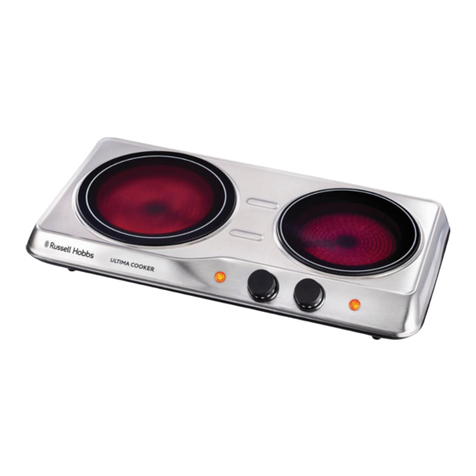
Russell Hobbs
Russell Hobbs RHIRH4 Instructions and warranty
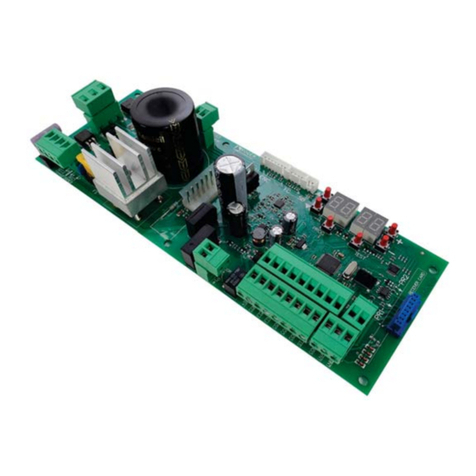
Roger Technology
Roger Technology B70/1DCHP quick start

Kenmore
Kenmore 79075232310 installation instructions
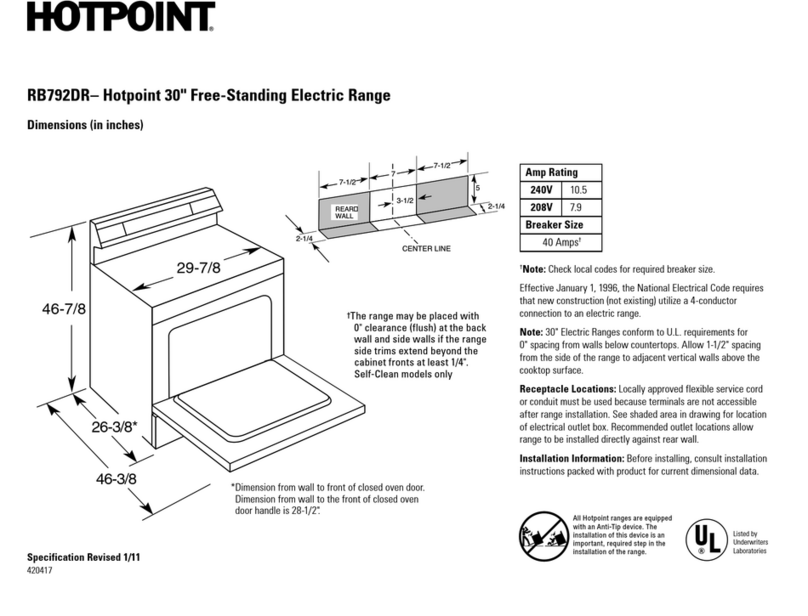
Hotpoint
Hotpoint RB792DRWW Dimension Guide

KitchenAid
KitchenAid KERS807SBB installation instructions

KitchenAid
KitchenAid KEDS100W Use and care guide
